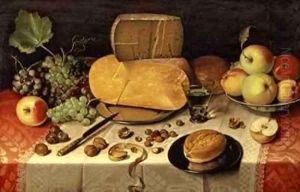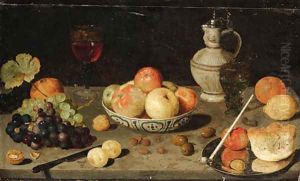Floris Claesz. van Dyck Paintings
Floris Claesz. van Dyck, often simply referred to as Floris van Dyck, was a notable Dutch painter born in 1575, during the late Renaissance period, which transitioned into what is known as the Dutch Golden Age. He was predominantly active in Haarlem, where he became an important figure in the development of still life painting, a genre that Dutch artists would come to dominate and innovate throughout the 17th century. Despite the common association of the Van Dyck surname with the Flemish Baroque artist Anthony van Dyck, Floris was part of the distinct Dutch artistic tradition, with no direct relation to the Flemish painter.
Van Dyck's work is characterized by its meticulous attention to detail, vibrant colors, and the ability to render textures in a lifelike manner. He specialized in still lifes, particularly those featuring food and banquet tables laden with an abundance of fruits, bread, and other fare, which were popular among the wealthy merchant class in the Netherlands. These compositions not only displayed his technical skill but also served as a reflection of the wealth and abundance of the Dutch Republic during its Golden Age. Additionally, his paintings often contained moral or vanitas themes, reminding viewers of the transience of life and the futility of pleasure.
During his lifetime, Floris van Dyck played a role in the Haarlem Guild of St. Luke, a common institution for artists of the time, which helped to organize the local art market and provided a network for commissions. His influence was felt by a number of other Dutch still-life painters, contributing to the genre's evolution. Despite the relative scarcity of biographical details about his life beyond his artistic career, his works have endured as exemplars of early Dutch still-life painting, held in high regard and featured in collections and museums around the world.
Floris Claesz. van Dyck passed away in 1651, in Haarlem. His legacy is preserved through his contributions to the Dutch Golden Age of painting, particularly in the still-life genre, which continued to flourish and evolve long after his death. Through his art, he has left an indelible mark on the history of Dutch painting, embodying the era's spirit of exploration, commercial success, and cultural achievement.

